Abstract
Anthrax caused by Bacillus anthracis in humans is rare. Two recent outbreaks that were intentionally caused occurred among postal employees, politicians, and journalists in the United States. This has caused tremendous fear, and our experience with these "anthrax incidents" has changed our views on the natural history of this disease in people. In this paper, we review the lifecycle and biology of this micro-organism. Anthrax that occurs from a weaponized form of this micro-organism has a specific clinical presentation that requires a suspicion of anthrax exposure to be diagnosed. New methods of testing for anthrax have been developed and may simplify diagnosis in the future. The range of illness caused by B. anthracis from the molecular level to the clinical symptoms is discussed. We also review the diagnostic criteria and differential diagnosis as well as treatment of this condition.
Full text
PDF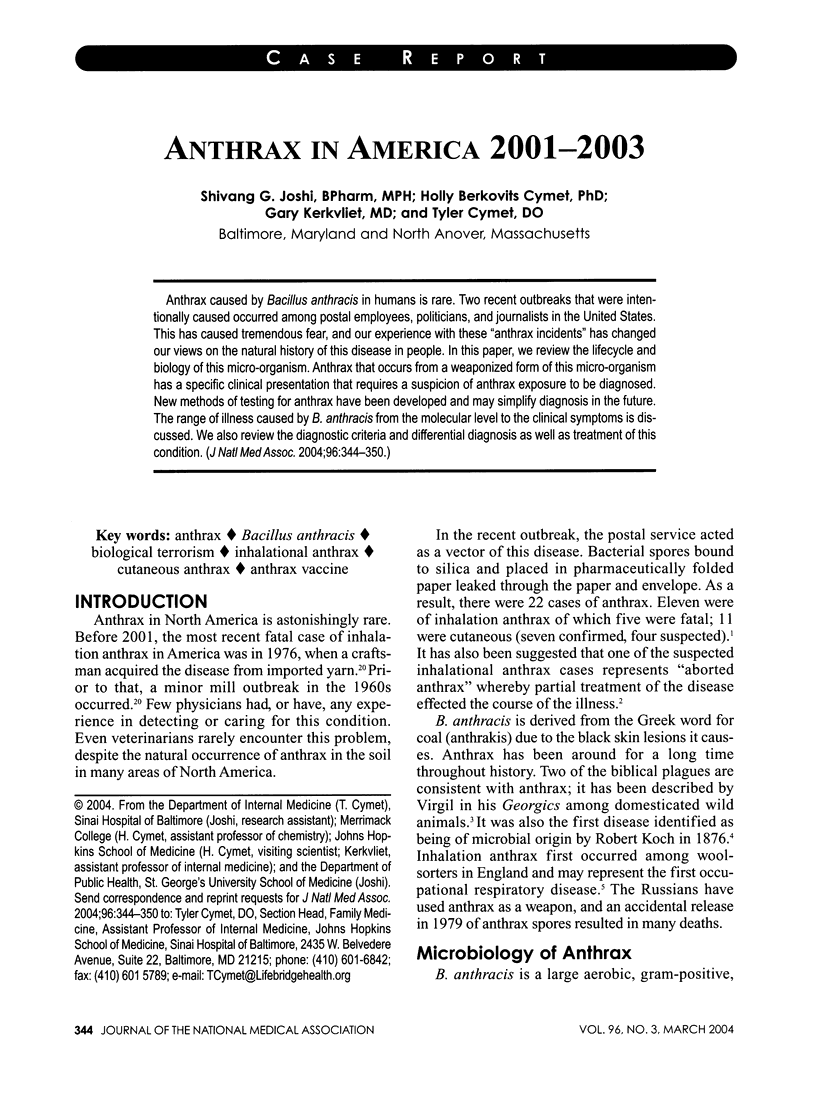
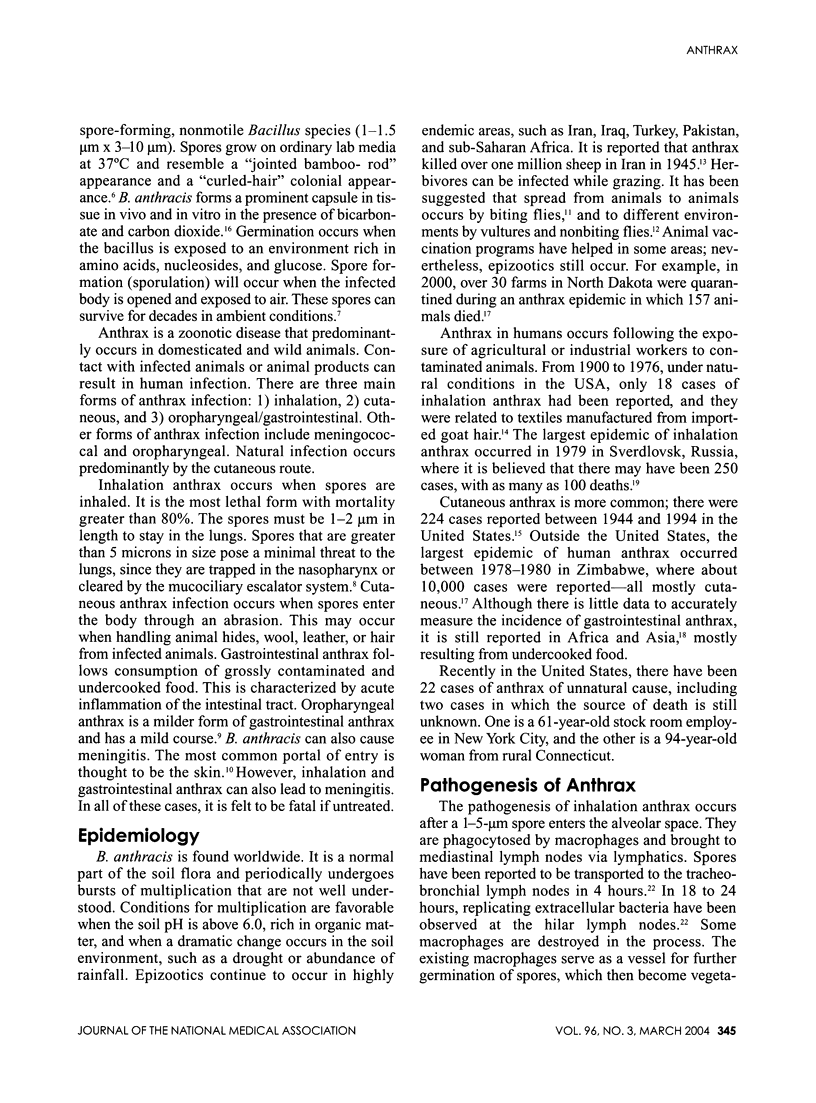
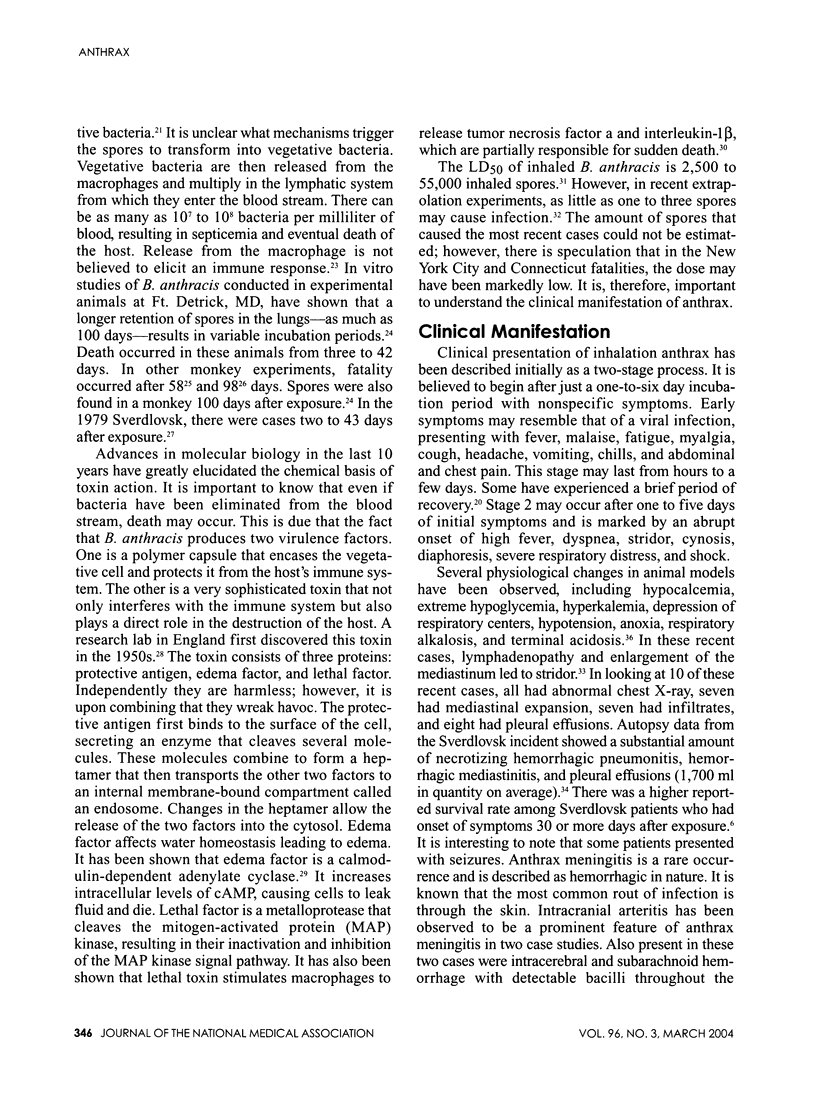
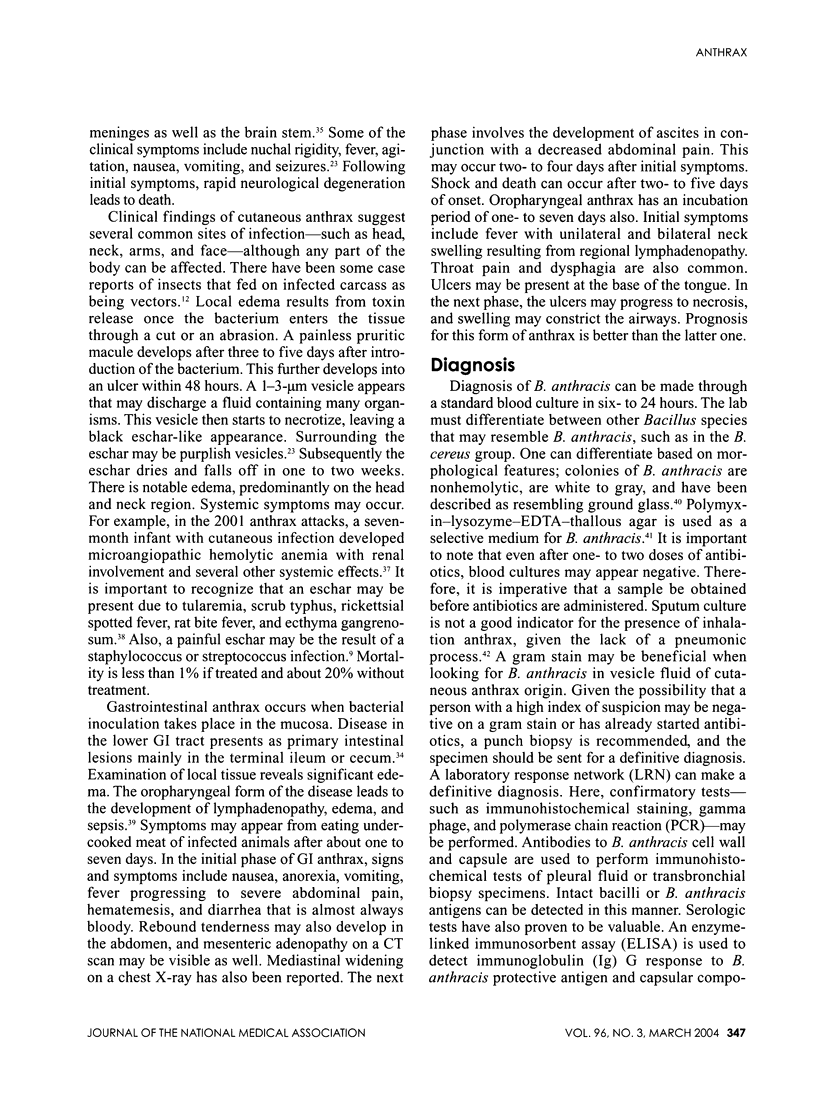
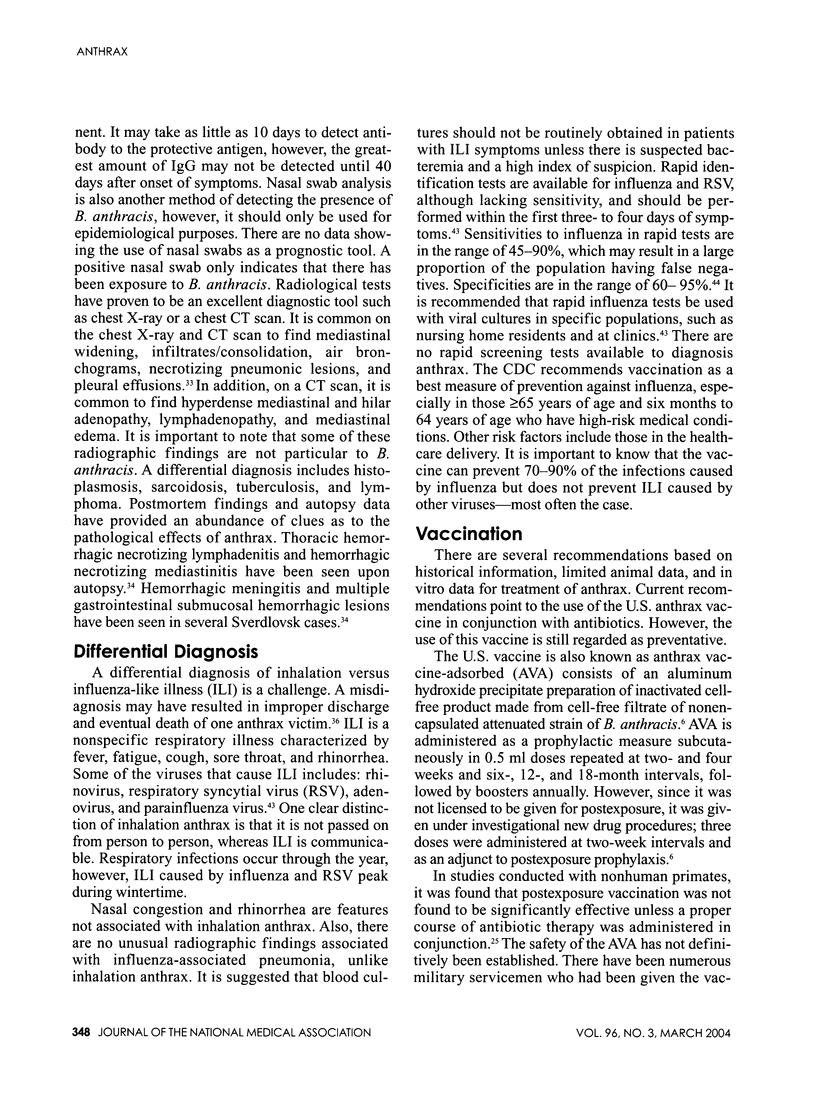
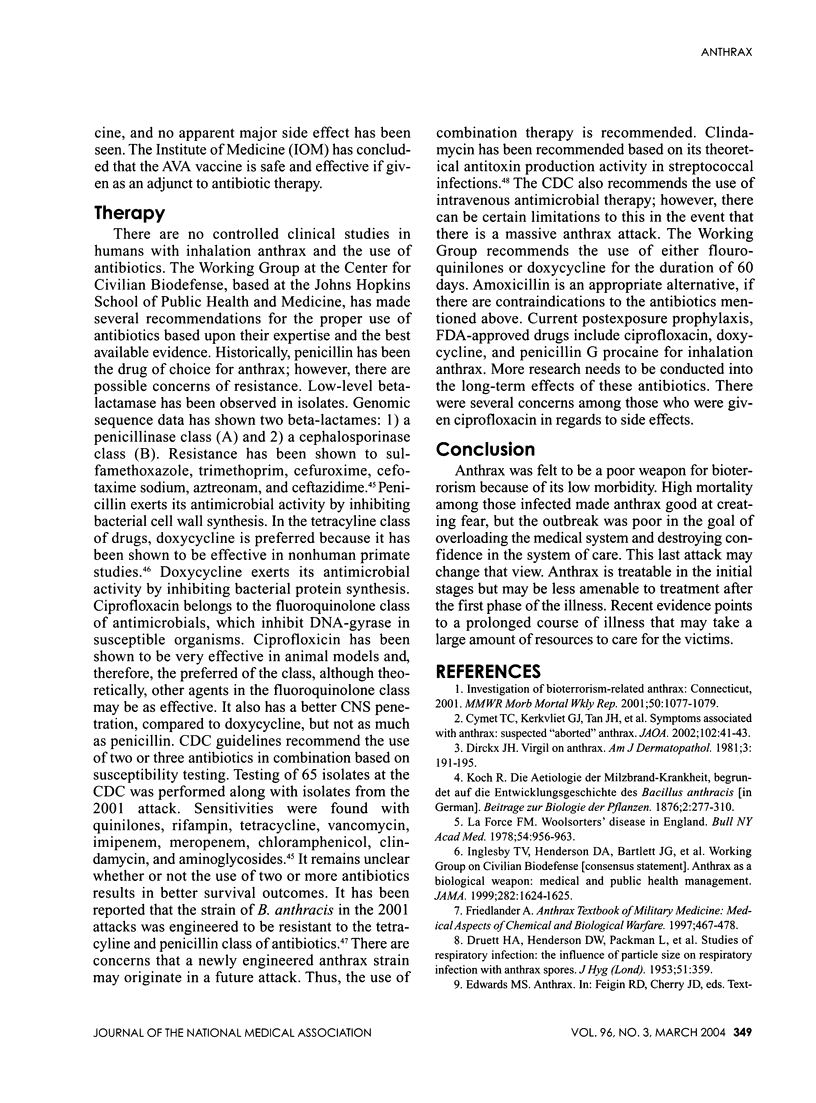
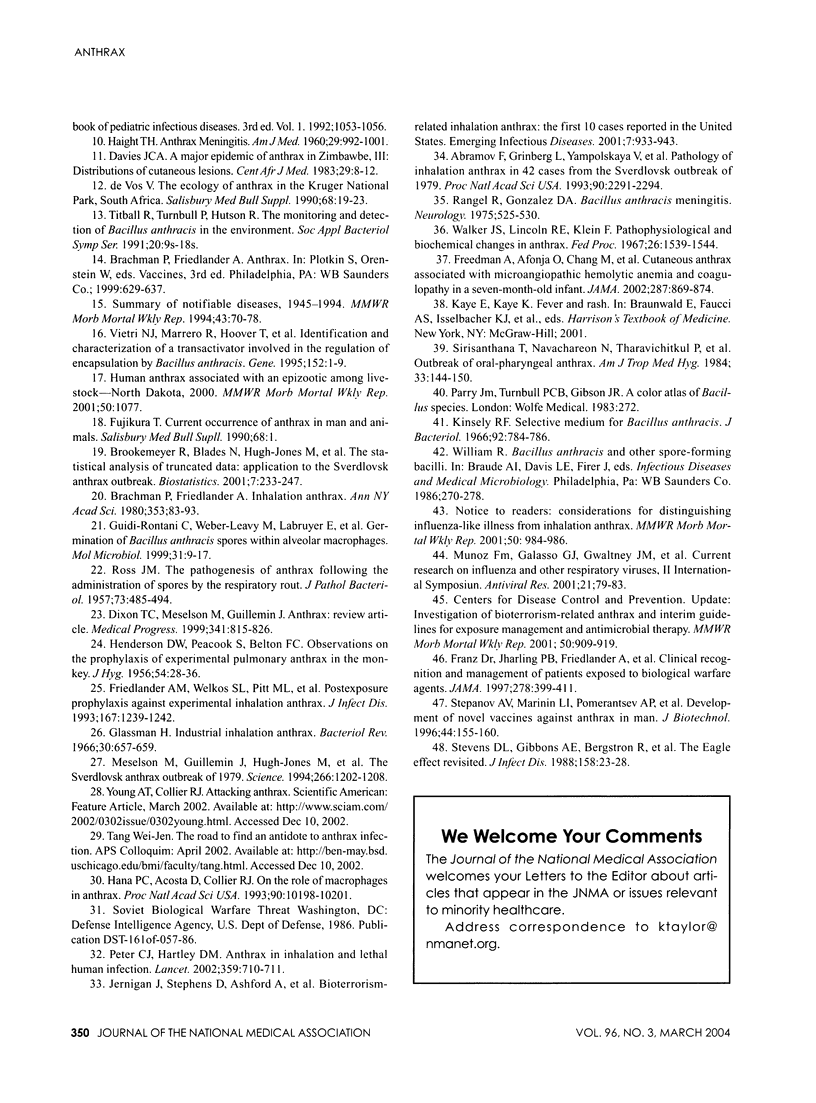
Selected References
These references are in PubMed. This may not be the complete list of references from this article.
- Abramova F. A., Grinberg L. M., Yampolskaya O. V., Walker D. H. Pathology of inhalational anthrax in 42 cases from the Sverdlovsk outbreak of 1979. Proc Natl Acad Sci U S A. 1993 Mar 15;90(6):2291–2294. doi: 10.1073/pnas.90.6.2291. [DOI] [PMC free article] [PubMed] [Google Scholar]
- Brachman P. S. Inhalation anthrax. Ann N Y Acad Sci. 1980;353:83–93. doi: 10.1111/j.1749-6632.1980.tb18910.x. [DOI] [PubMed] [Google Scholar]
- Brookmeyer R., Blades N., Hugh-Jones M., Henderson D. A. The statistical analysis of truncated data: application to the Sverdlovsk anthrax outbreak. Biostatistics. 2001 Jun;2(2):233–247. doi: 10.1093/biostatistics/2.2.233. [DOI] [PubMed] [Google Scholar]
- Centers for Disease Control and Prevention (CDC) Update: Investigation of bioterrorism-related anthrax and interim guidelines for exposure management and antimicrobial therapy, October 2001. MMWR Morb Mortal Wkly Rep. 2001 Oct 26;50(42):909–919. [PubMed] [Google Scholar]
- Cymet Tyler C., Kerkvliet Gary J., Tan Judy H., Gradon Jeremy D. Symptoms associated with anthrax exposure: suspected "aborted" anthrax. J Am Osteopath Assoc. 2002 Jan;102(1):41–43. [PubMed] [Google Scholar]
- DRUETT H. A., HENDERSON D. W., PACKMAN L., PEACOCK S. Studies on respiratory infection. I. The influence of particle size on respiratory infection with anthrax spores. J Hyg (Lond) 1953 Sep;51(3):359–371. doi: 10.1017/s0022172400015795. [DOI] [PMC free article] [PubMed] [Google Scholar]
- Dirckx J. H. Virgil on anthrax. Am J Dermatopathol. 1981 Summer;3(2):191–195. doi: 10.1097/00000372-198100320-00012. [DOI] [PubMed] [Google Scholar]
- Dixon T. C., Meselson M., Guillemin J., Hanna P. C. Anthrax. N Engl J Med. 1999 Sep 9;341(11):815–826. doi: 10.1056/NEJM199909093411107. [DOI] [PubMed] [Google Scholar]
- Freedman Abigail, Afonja Olubunmi, Chang Mary Wu, Mostashari Farzad, Blaser Martin, Perez-Perez Guillermo, Lazarus Herb, Schacht Robert, Guttenberg Jane, Traister Michael. Cutaneous anthrax associated with microangiopathic hemolytic anemia and coagulopathy in a 7-month-old infant. JAMA. 2002 Feb 20;287(7):869–874. doi: 10.1001/jama.287.7.869. [DOI] [PubMed] [Google Scholar]
- Friedlander A. M., Welkos S. L., Pitt M. L., Ezzell J. W., Worsham P. L., Rose K. J., Ivins B. E., Lowe J. R., Howe G. B., Mikesell P. Postexposure prophylaxis against experimental inhalation anthrax. J Infect Dis. 1993 May;167(5):1239–1243. doi: 10.1093/infdis/167.5.1239. [DOI] [PubMed] [Google Scholar]
- Glassman H. N. Discussion. Bacteriol Rev. 1966 Sep;30(3):657–659. doi: 10.1128/br.30.3.657-659.1966. [DOI] [PMC free article] [PubMed] [Google Scholar]
- Guidi-Rontani C., Weber-Levy M., Labruyère E., Mock M. Germination of Bacillus anthracis spores within alveolar macrophages. Mol Microbiol. 1999 Jan;31(1):9–17. doi: 10.1046/j.1365-2958.1999.01137.x. [DOI] [PubMed] [Google Scholar]
- HENDERSON D. W., PEACOCK S., BELTON F. C. Observations on the prophylaxis of experimental pulmonary anthrax in the monkey. J Hyg (Lond) 1956 Mar;54(1):28–36. doi: 10.1017/s0022172400044272. [DOI] [PMC free article] [PubMed] [Google Scholar]
- Hanna P. C., Acosta D., Collier R. J. On the role of macrophages in anthrax. Proc Natl Acad Sci U S A. 1993 Nov 1;90(21):10198–10201. doi: 10.1073/pnas.90.21.10198. [DOI] [PMC free article] [PubMed] [Google Scholar]
- Jernigan J. A., Stephens D. S., Ashford D. A., Omenaca C., Topiel M. S., Galbraith M., Tapper M., Fisk T. L., Zaki S., Popovic T. Bioterrorism-related inhalational anthrax: the first 10 cases reported in the United States. Emerg Infect Dis. 2001 Nov-Dec;7(6):933–944. doi: 10.3201/eid0706.010604. [DOI] [PMC free article] [PubMed] [Google Scholar]
- Meselson M., Guillemin J., Hugh-Jones M., Langmuir A., Popova I., Shelokov A., Yampolskaya O. The Sverdlovsk anthrax outbreak of 1979. Science. 1994 Nov 18;266(5188):1202–1208. doi: 10.1126/science.7973702. [DOI] [PubMed] [Google Scholar]
- Nalin D. R. Recognition and treatment of anthrax. JAMA. 1999 Nov 3;282(17):1624–1625. [PubMed] [Google Scholar]
- Peters C. J., Hartley D. M. Anthrax inhalation and lethal human infection. Lancet. 2002 Feb 23;359(9307):710–711. doi: 10.1016/s0140-6736(02)07792-9. [DOI] [PubMed] [Google Scholar]
- Rangel R. A., González D. A. Bacillus anthracic meningitis. Neurology. 1975 Jun;25(6):525–530. doi: 10.1212/wnl.25.6.525. [DOI] [PubMed] [Google Scholar]
- Sirisanthana T., Navachareon N., Tharavichitkul P., Sirisanthana V., Brown A. E. Outbreak of oral-oropharyngeal anthrax: an unusual manifestation of human infection with Bacillus anthracis. Am J Trop Med Hyg. 1984 Jan;33(1):144–150. doi: 10.4269/ajtmh.1984.33.144. [DOI] [PubMed] [Google Scholar]
- Stepanov A. V., Marinin L. I., Pomerantsev A. P., Staritsin N. A. Development of novel vaccines against anthrax in man. J Biotechnol. 1996 Jan 26;44(1-3):155–160. doi: 10.1016/0168-1656(95)00092-5. [DOI] [PubMed] [Google Scholar]
- Stevens D. L., Gibbons A. E., Bergstrom R., Winn V. The Eagle effect revisited: efficacy of clindamycin, erythromycin, and penicillin in the treatment of streptococcal myositis. J Infect Dis. 1988 Jul;158(1):23–28. doi: 10.1093/infdis/158.1.23. [DOI] [PubMed] [Google Scholar]
- Vietri N. J., Marrero R., Hoover T. A., Welkos S. L. Identification and characterization of a trans-activator involved in the regulation of encapsulation by Bacillus anthracis. Gene. 1995 Jan 11;152(1):1–9. doi: 10.1016/0378-1119(94)00662-c. [DOI] [PubMed] [Google Scholar]
- Walker J. S., Lincoln R. E., Klein F. Pathophysiological and biochemical changes in anthrax. Fed Proc. 1967 Sep;26(5):1539–1544. doi: 10.21236/ad0811760. [DOI] [PubMed] [Google Scholar]


